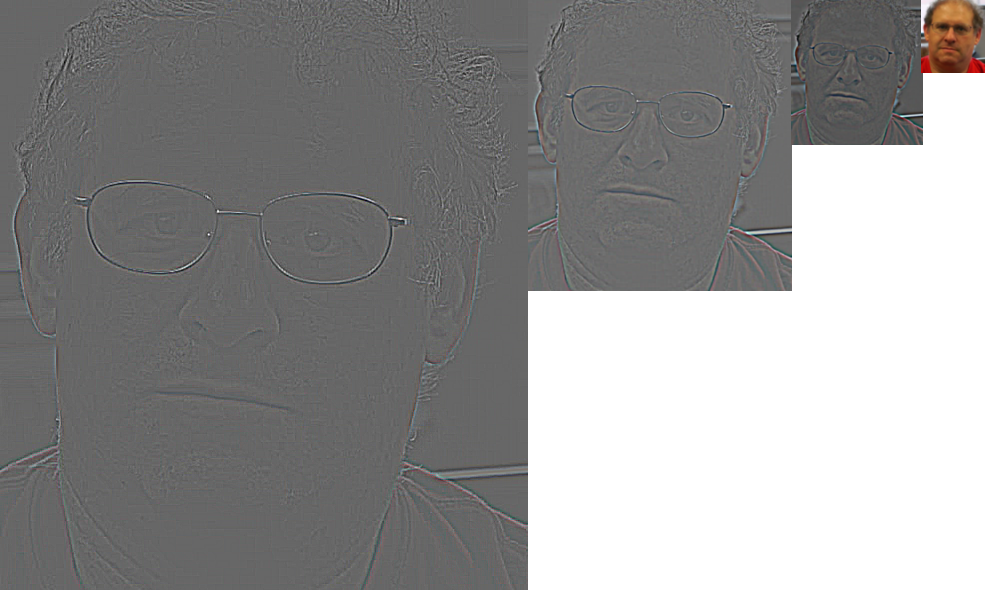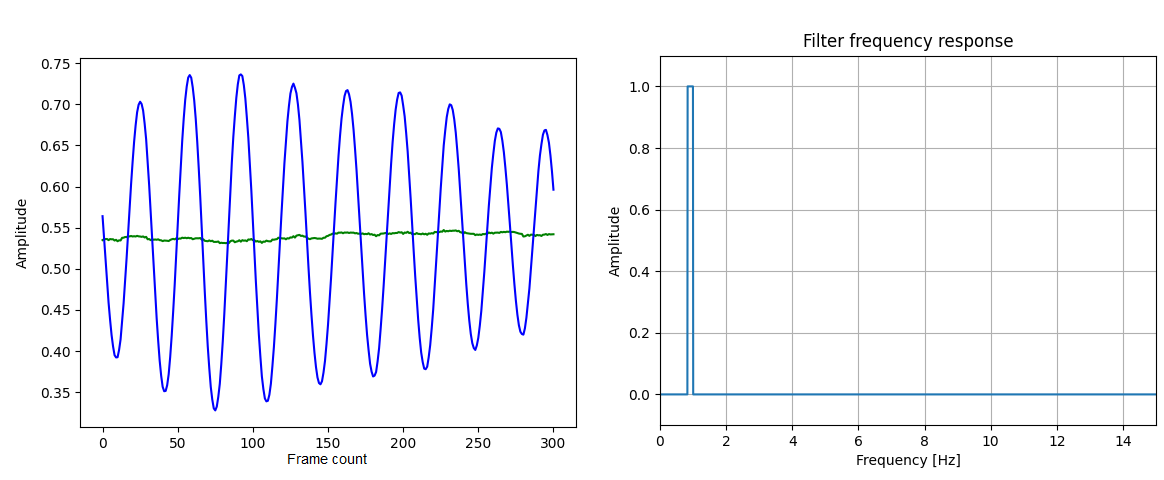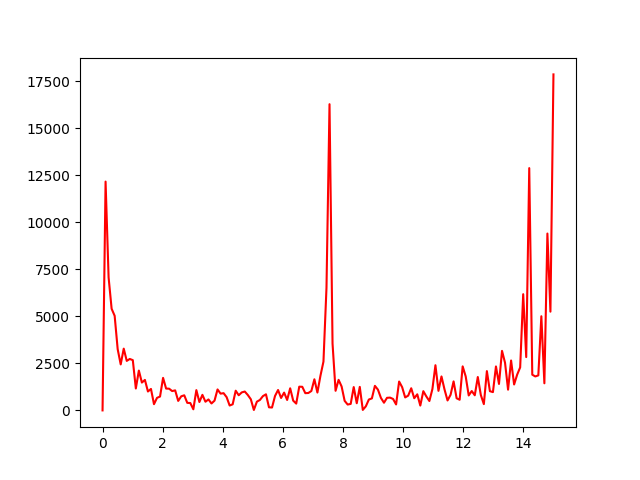

We will be implementing a video magnification technique introduced in the paper
"Eulerian Video Magnification for Revealing Subtle Changes in the World" (TOG 2012).
The codes are written in Python >=3.8 with the help of some basic libraries.
In order to run the code, first unzip the codes and run
pip install -r requirements.txt
in the desired Python enviornment.
import cv2
import numpy as np
from scipy import signal
import matplotlib.pyplot as plt
We will load the video file with the help of the opencv-python library which allows us to read videos frame by frame.
We can also obtain some video related meta information such as video frame count, frames per second, height, and width.
We will store the values with double-precision since our operations will be conducted in the range of 0-1.
video_name = 'face'
cap = cv2.VideoCapture(f'./data/{video_name}.mp4')
HEIGHT, WIDTH = int(cap.get(cv2.CAP_PROP_FRAME_HEIGHT)), int(cap.get(cv2.CAP_PROP_FRAME_WIDTH))
FRAME_COUNT, FPS = int(cap.get(cv2.CAP_PROP_FRAME_COUNT)), int(cap.get(cv2.CAP_PROP_FPS))
rgb_video = []
for i in range(FRAME_COUNT):
ret, frame = cap.read()
if ret:
frame = cv2.cvtColor(frame, cv2.COLOR_BGR2RGB)
rgb_video.append(frame)
else:
print('ill frame')
break
cap.release()
We will then convert the color space of the video from RGB to the YIQ color space. According to the definition of the YIQ color space in Wikipedia, we are able to convert between color spaces with a simple linear transormation.
# Float64 in range [0,1]
rgb_video = np.array(rgb_video) / 255
# RGB to YIQ transformation
# https://en.wikipedia.org/wiki/YIQ
rgb2yiq = np.array([[0.299, 0.587, 0.114],
[0.596,-0.275,-0.321],
[0.212,-0.523, 0.311]])
yiq2rgb = np.array([[1.000, 0.956, 0.619],
[1.000,-0.272,-0.647],
[1.000,-1.106, 1.703]])
yiq_video = np.dot(rgb_video, rgb2yiq.T.copy())
Once we have loaded the video in a numpy array, we then construct a Laplacian pyramid of the video.
The Laplacian pyramid is constructed independently for each frame and consists of processes such as
down sampling with a Gaussian filter and calculating the difference between the original and filtered image.
This can be easily done by the pyrUp and pyrDown function from the opencv-python library,
which upsamples/downsamples an image with a Gaussian filter.
Utilizing the pyrUp, pyrDown functions,
we first construct a Gaussian image pyramid and obtain the Laplacian counterpart by subtracting the neighboring stages.
yiq_video_gaussian_pyramid = {'g0':[], 'g1':[], 'g2':[], 'g3':[], }
yiq_video_laplacian_pyramid = {'l0':[], 'l1':[], 'l2':[], 'l3':[], }
yiq_video_gaussian_pyramid['g0'] = yiq_video.copy()
for frame in yiq_video:
g1 = cv2.pyrDown(frame)
_g1 = cv2.pyrUp(g1)
yiq_video_gaussian_pyramid['g1'].append(g1)
yiq_video_laplacian_pyramid['l0'].append(frame - _g1)
g2 = cv2.pyrDown(g1)
_g2 = cv2.pyrUp(g2)
yiq_video_gaussian_pyramid['g2'].append(g2)
yiq_video_laplacian_pyramid['l1'].append(g1 - _g2)
g3 = cv2.pyrDown(g2)
_g3 = cv2.pyrUp(g3)
yiq_video_gaussian_pyramid['g3'].append(g3)
yiq_video_laplacian_pyramid['l2'].append(g2 - _g3)
for k, value in yiq_video_gaussian_pyramid.items():
yiq_video_gaussian_pyramid[k] = np.array(value)
for k, value in yiq_video_laplacian_pyramid.items():
yiq_video_laplacian_pyramid[k] = np.array(value)
yiq_video_laplacian_pyramid['l3'] = yiq_video_gaussian_pyramid['g3'].copy()

# reconstructing the original frame
_first_frame = (np.dot(yiq_video_gaussian_pyramid['g0'][0], yiq2rgb.T) * 255).astype(np.uint8)
_reconstructed_first_frame = cv2.pyrUp(
cv2.pyrUp(
cv2.pyrUp(yiq_video_laplacian_pyramid['l3'][0]) \
+ yiq_video_laplacian_pyramid['l2'][0]) \
+ yiq_video_laplacian_pyramid['l1'][0]) \
+ yiq_video_laplacian_pyramid['l0'][0]
_reconstructed_first_frame = (np.dot(_reconstructed_first_frame, yiq2rgb.T) * 255).astype(np.uint8)
cv2.imwrite('1_Reconstructed_Pyramid.png', cv2.cvtColor(_reconstructed_first_frame, cv2.COLOR_RGB2BGR))
print('Reconstructed images are '
f'{"identical" if np.array_equal(_first_frame, _reconstructed_first_frame) else "different"}')
Now for the main event, we will apply the same bandpass filter for each pixel along the temporal axis.
For ideal filters, we convert the signal into the frequency domain using the np.fft module.
Specifically, the rfft function does not return the redundant half of the Fourier transform result
and enables us to directly mask certain frequencies to zero.
A signle index of the DFT result corresponds to FPS/FRAME_COUNT Hz of the origianl signal.
We return the signal after passing the bandpass filter so that we can amplify this signal by a specified constant AMP_VALUE.
For butterworth filters, we use the scipy.signal library for both creating and applying filters to videos,
which can be easily done with a few lines.
# create filter
if video_name == 'face':
LOW_FREQ, HIGH_FREQ = 0.83, 1.0
AMP_VALUE = 100
sos = None
elif video_name == 'baby':
LOW_FREQ, HIGH_FREQ = 0.4, 3
AMP_VALUE = 10
sos = signal.butter(1, [LOW_FREQ, HIGH_FREQ], btype='band', output='sos', fs=FPS)
elif video_name == 'baby2':
LOW_FREQ, HIGH_FREQ = 2.33, 2.67
AMP_VALUE = 150
sos = None
elif video_name == 'subway':
LOW_FREQ, HIGH_FREQ = 3.6, 6.2
AMP_VALUE = 15
sos = signal.butter(1, [LOW_FREQ, HIGH_FREQ], btype='band', output='sos', fs=FPS)
elif video_name == 'watch':
LOW_FREQ, HIGH_FREQ = 4, 12
AMP_VALUE = 10
sos = signal.butter(1, [LOW_FREQ, HIGH_FREQ], btype='band', output='sos', fs=FPS)
else:
raise NotImplementedError
# visualize filter
plt.figure(0)
if sos is not None:
NYQ = 0.5 * FPS
w, h = signal.sosfreqz(sos, worN=2048)
plt.plot((NYQ / np.pi) * w, abs(h))
else:
w = np.linspace(0, 15, 2048)
h = [1 if LOW_FREQ <= x and x <= HIGH_FREQ else 0 for x in w]
plt.plot(w, h)
def band_pass_filter(data, low_cut, high_cut, fs):
low_cut, high_cut = int(low_cut * FRAME_COUNT / fs), int(high_cut * FRAME_COUNT / fs)
rfft = np.fft.rfft(data, axis=0)
rfft[:low_cut] = 0
rfft[high_cut+1:] = 0
return np.fft.irfft(rfft, n=FRAME_COUNT, axis=0).real
yiq_video_laplacian_pyramid_amplified = {}
for stage, video in sorted(yiq_video_laplacian_pyramid.items()):
if sos is None:
if stage in ['l0', 'l1']:
yiq_video_laplacian_pyramid_amplified[stage] = yiq_video_laplacian_pyramid[stage]
continue
yiq_video_laplacian_pyramid_amplified[stage] = yiq_video_laplacian_pyramid[stage] \
+ band_pass_filter(yiq_video_laplacian_pyramid[stage], \
LOW_FREQ, HIGH_FREQ, FPS) * AMP_VALUE
else:
yiq_video_laplacian_pyramid_amplified[stage] = yiq_video_laplacian_pyramid[stage] \
+ signal.sosfilt(sos, yiq_video_laplacian_pyramid[stage], axis=0)\
* AMP_VALUE
Bellow are the amplified signal and the bandpass filter used for the "face.mp4" video.

I was not successful at this problem, as I was not able to identify what frequencies should be amplified. For a naive start, I tried averaging along the spatial dimension to obtain a 1D-signal and analyzed the frequency of that signal. However, I was not able to find anything special near 1Hz. This seemed to be an obvious result since the frequency that needs to be amplified wouldn't have a high amplitude at the first place.
yiq_video_averaged = np.sum(yiq_video, axis=(1,2,3))
yiq_video_averaged_fft = np.fft.fft(yiq_video_averaged, axis=0)
# Remove DC component
yiq_video_averaged_fft[(FRAME_COUNT+1)//2] = 0.
plt.figure(2)
f = np.linspace(0, FPS//2, FRAME_COUNT//2)
plt.plot(f, np.abs(yiq_video_averaged_fft)[(FRAME_COUNT + 1) // 2:], color='r')
plt.savefig('3_Frequency_Analysis.png')

I think the best effort would be to use specific domain knowledge. (e.g., heartbeat is around 0.83Hz - 1.0Hz)
Collapsing the Laplacian pyramid is the same process as seen above. The results for blood flow amplification are seen bellow. The video has some artifacts in regions out-of-interest since the original paper proposed extensive spatial filtering which our project did not consider.
We also experiment on the motion-magnification videos provided in the original paper, namely "baby.mp4" and "subway.mp4". We can observe the motions getting amplified even though we did not perform any spatial-aware operation.
print('Saving video...')
fourcc = cv2.VideoWriter_fourcc(*'mp4v')
writer = cv2.VideoWriter(f'5_Amplified_{video_name}.mp4', fourcc, FPS, (WIDTH, HEIGHT))
for i in range(FRAME_COUNT):
yiq_reconstructed_frame = cv2.pyrUp(
cv2.pyrUp(
cv2.pyrUp(yiq_video_laplacian_pyramid_amplified['l3'][i]) \
+ yiq_video_laplacian_pyramid_amplified['l2'][i]) \
+ yiq_video_laplacian_pyramid_amplified['l1'][i]) \
+ yiq_video_laplacian_pyramid_amplified['l0'][i]
_rgb_reconstructed_frame = np.clip(np.dot(yiq_reconstructed_frame, yiq2rgb.T), 0, 1)
rgb_reconstructed_frame = (_rgb_reconstructed_frame * 255).astype(np.uint8)
frame = cv2.cvtColor(rgb_reconstructed_frame, cv2.COLOR_RGB2BGR)
writer.write(frame)
writer.release()
I recorded the bunny inside my watch jump up and down with my smart phone. My aim was to magnify the bunny's motion, but I ended up finding some parameters that magnify the moire patterns, leading to the bunny being colorful.
I amplified the signals between 0.5Hz to 3Hz with the butterworth filter with a factor of 10.